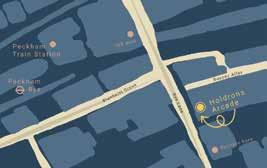
3 minute read
Garden Talk
from SE23 November 2022
by SE Magazines
Grow Your Own Apples
Garden Talk with Janine Winlaw | Instagram @janinewinlaw
There’s nothing more satisfying, tasty and healthy than picking and eating your own homegrown apples. And with pretty pink- tinged blossom in spring and glowing autumn fruit, an apple tree adds an attractive and romantic feel to a garden and is wonderful for wildlife too You can plant bare root apple trees from November through to March. Here’s what you need to know. Apple trees can act as a focal point in a lawn or provide structure in borders. And because they’re grafted onto rootstocks producing different sized trees, there’s an apple tree to fit every garden. The most vigorous rootstocks, M111 and M25, make large standard trees to sit under, and are wonderful for wild orchards under planted with bulbs. However, even urban gardens can have an orchard if there’s room for five trees, argues author Naomi Slade in her excellent book An Orchard Odyssey, it just might mean using smaller trees such as semi dwarfing MM106. Otherwise M26, M9 and M27 make smaller trees still and can be trained and pruned into espaliers and fans, flat against a wall or fence, ideal for making the best use of space and maximising productivity. Apples can also be grown in containers or trained into cordons – single stems with short side shoots – I’ve seen a row of these trained diagonally making an attractive and productive hedge. And step overs, cordons grown horizontally, around 45cm off the ground, are perfect for lining a path or edging a bed. There are thousands of different apple varieties to choose from flowering and cropping at different times. It’s best to plant at least two apples from the same or adjacent groups (of which there are 6) so that they can pollinate each other. If there’s an apple tree in a neighbouring garden in the right group, that may even be enough.
Early Varieties
Discovery. A popular disease resistant red dessert apple. Sunrise. An early red apple and one of the best. Worcester Pearmain. An early sweet red apple.
Mid Season Varieties
Jupiter. Similar to Cox’s Orange Pippin but larger and redder in colour. Lord Lambourne. A traditional English apple with crisp, juicy, sweet apples. Delicious!
Late Varieties
Blenheim Orange. A classic English heritage variety with a distinctive flavour. Topaz. A crisp, sharp dessert apple with red flushed skin. Braeburn. A popular sweet, crisp apple. Elstar. One of the best modern apples with an excellent fruity flavour. Spartan. A popular heavy cropping dark red dessert apple. You can buy trees bare root between November and early March, or in containers for planting the rest of the year. Plant your tree in a warm position with free draining soil that gets around 6 hours of sun. Keep their bases weed free and mulch in the early years, and you’ll reap the rewards in years to come.
Stephen J. Smith
F.C.C.A.
Local Chartered Certified Accountant with 30 years small business experience Small Business Accounting Financial Administration & Reporting Payroll VAT Personal Tax Advice Tax Compliance Inheritance Tax Advice
020 8693 1581 | 07931 558480 ssmith@sjsaccountants.co.uk www.sjsaccountants.co.uk
BEST EVER PRICES FOR FLEXIBLE BOOKINGS
Room 12a
The Secret’s Out Room 12a is open for lovers… • of Vintage posters and lobby cards • of Original drawings & paintings • of Parody Mexican retablo (visit to find out more!) • of Mid-Century modern ceramics
And…and…and…
Room 12a is in Holdrons Arcade, 135a, Peckham Rye Lane, SE15 4ST.
Instagram: @Room12a_
Open: Wed-Sun 11.306.00pm
Original film poster by A. Lemeshenko for We Live Here, the 1956 romantic melodrama.







